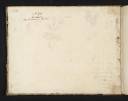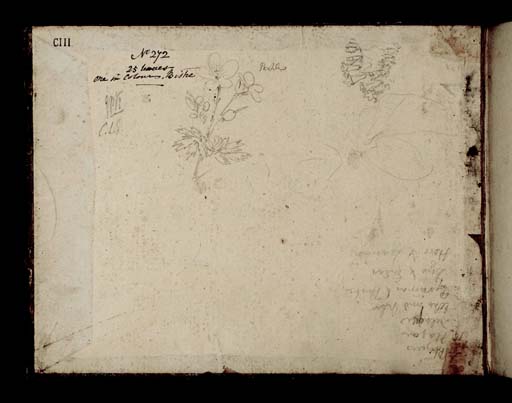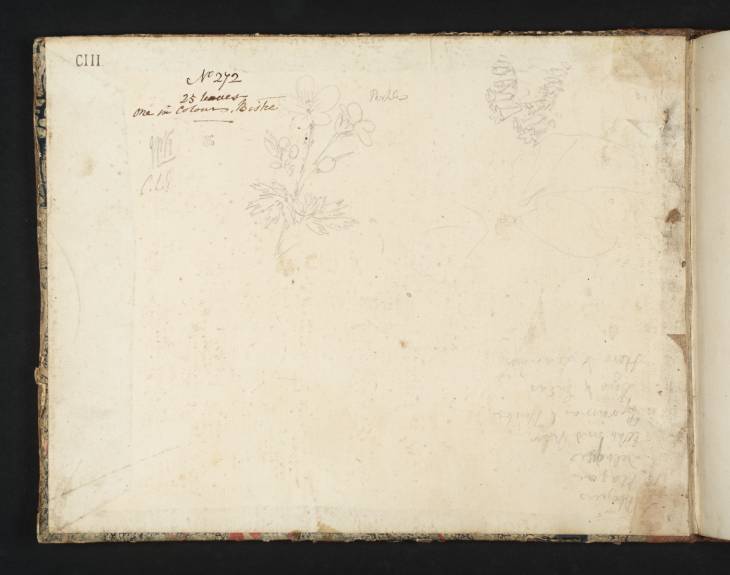Joseph Mallord William Turner Studies of Plants, and List of Historical Subjects (Inscription by Turner) c.1808
Image 1 of 2
-
 Joseph Mallord William Turner, Studies of Plants, and List of Historical Subjects (Inscription by Turner) c.1808 (Inside back cover of sketchbook)Inside back cover of sketchbook
Joseph Mallord William Turner, Studies of Plants, and List of Historical Subjects (Inscription by Turner) c.1808 (Inside back cover of sketchbook)Inside back cover of sketchbook -
 Joseph Mallord William Turner, Studies of Plants, and List of Historical Subjects (Inscription by Turner) c.1808 (Enhanced image)Enhanced image
Joseph Mallord William Turner, Studies of Plants, and List of Historical Subjects (Inscription by Turner) c.1808 (Enhanced image)Enhanced image
Inside back cover of sketchbook
Joseph Mallord William Turner,
Studies of Plants, and List of Historical Subjects (Inscription by Turner)
c.1808
(Inside back cover of sketchbook)
Joseph Mallord William Turner 1775–1851
Inside Back Cover:
Studies of Plants, and List of Historical Subjects (Inscription by Turner) circa 1808
D40721
Pencil on off-white wove paper, 226 x 294 mm
Inscribed by Turner in pencil (see main catalogue entry)
Inscribed by the Executors of the Turner Bequest in ink (see main catalogue entry)
Stamped in black ‘CIII’
Inscribed by Turner in pencil (see main catalogue entry)
Inscribed by the Executors of the Turner Bequest in ink (see main catalogue entry)
Stamped in black ‘CIII’
Accepted by the nation as part of the Turner Bequest 1856
References
1909
A.J. Finberg, A Complete Inventory of the Drawings of the Turner Bequest, London 1909, vol.I, p.271, CIII.
1996
Gillian Forrester, Turner’s ‘Drawing Book’: The Liber Studiorum, exhibition catalogue, Tate Gallery, London 1996, pp.154, 158 (Appendix A).
Turner’s list reads:
5 Plague
10 Plague
Deluge
Echo and Nar
Pyramus and Thisbe
Dido and Aeneas
Hero and Leander
10 Plague
Deluge
Echo and Nar
Pyramus and Thisbe
Dido and Aeneas
Hero and Leander
This list names historical, biblical and classical subjects used or presumably intended for the Liber Studiorum and inspired by pictures by Nicolas Poussin or perhaps also Richard Wilson. Four subjects were engraved for the Liber while others were painted. Only one, Pyramus and Thisbe, is otherwise unknown. The Fifth Plague of Egypt (Indianapolis Museum of Art, Indiana)1 was exhibited in 1800 and later engraved for the Liber; for the drawing see Tate D08120; Turner Bequest CXVI S. The Tenth Plague of Egypt (Tate N00470)2 was exhibited in 1802 and later engraved for the Liber; for the drawing see Tate D08162; Turner Bequest CXVIII H. The Deluge (Tate N00493)3 may have been exhibited in 1805 and was engraved for but not published in the Liber; for the drawing see Tate D08178; Turner Bequest CXVIII X. Narcissus and Echo (Tate T03869; displayed at Petworth House)4 was exhibited in 1804 and reproduced in a soft-ground etching by Turner himself, presumably with the Liber in mind. Dido and Aeneas (Tate N00494)5 was not exhibited until 1814 but is seen in the planning in the earlier Studies for Pictures: Isleworth and Hesperides 1 sketchbooks (Tate D05520; Turner Bequest XC 21; D05773–D05778; Turner Bequest XCIII 4a, 5, 5a–7). The Parting of Hero and Leander – from the Greek of Musaeus (National Gallery, London)6 was only exhibited in 1837 but had an even longer gestation, reaching back to the Calais Pier sketchbook (Tate D04959; Turner Bequest LXXXI 57). Neither of these last subjects was used for the Liber.
While Turner’s interest in Poussin and Wilson stretched back some years, and in Poussin’s case especially to his visit to the Louvre in 1802, it could have been reinforced in 1808 by Richard Colt Hoare who owned examples of both artists’ work. Moreover Turner’s tour into North Wales that summer (see Introduction to the sketchbook) could have taken him to Wynnstay where, on an earlier visit, he had drawn Poussin’s Landscape with a Snake (National Gallery, London) in the collection of Sir Watkyn Williams Wynn; see the Dolbadarn sketchbook which contains both a sketch of Poussin’s picture and one for The Fifth Plague (Tate D02165, D02114; Turner Bequest XLVI 114a, 79).
The plant studies comprise a flowering stem, described by Turner in pencil as ‘Purple’, a blue-bell or campanula, and a slight sketch of petals or leaves.
Also present are the endorsement by the Executors of the Turner Bequest in ink ‘No 272 | 25 leaves | one in colours. Bistre’ and initials (in pencil) of John Prescott Knight and Charles Lock Eastlake ‘JPK’ and ‘C.L.E.’
David Blayney Brown
May 2010
How to cite
David Blayney Brown, ‘Studies of Plants, and List of Historical Subjects (Inscription by Turner) c.1808 by Joseph Mallord William Turner’, catalogue entry, May 2010, in David Blayney Brown (ed.), J.M.W. Turner: Sketchbooks, Drawings and Watercolours, Tate Research Publication, December 2012, https://www

